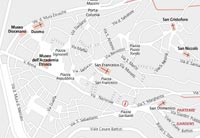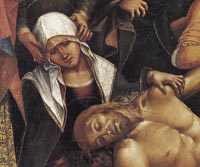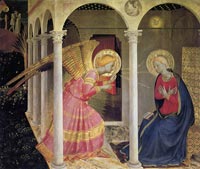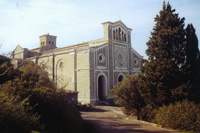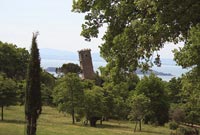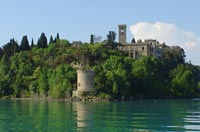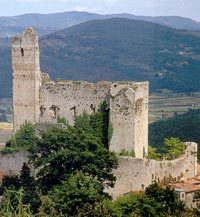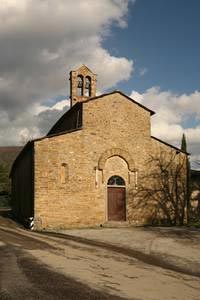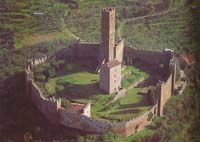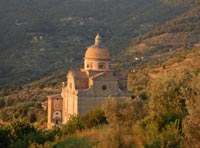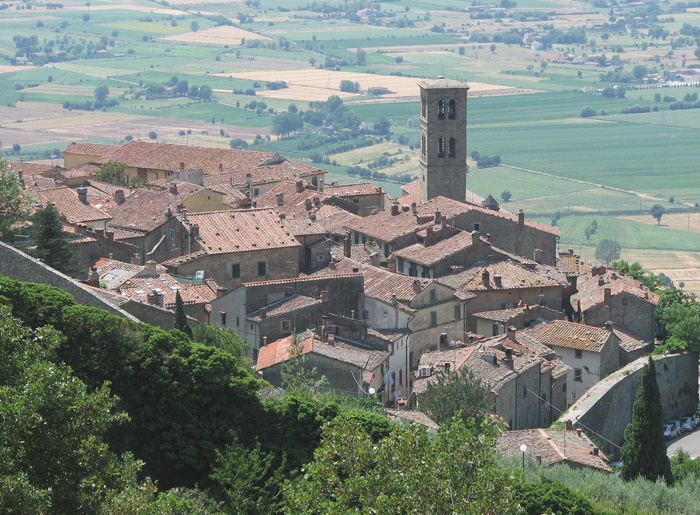 |
|
| N L | Cortona |
"... mother of Troy and grandmother of Rome" (Virgil - Aeneid III and IV) |
Cortona |
||
| The road to Cortona from the valley starts near the Melone Etruscan tombs. Located on the outskirts of the town are the Etruscan tombs, known as Tanella di Pitagora (2nd century B.C.) in the district of Cannaia. There are also Etruscan tombs ad hypogeum from the 6th and 7th centuries B.C. in the locality of Sodo and the beautiful 16th century temple of S. Maria delle Grazie at Calcinaio. On the way up the hill you'll pass more Etruscan tombs, olive groves, and the Renaissance Church of Santa Maria delle Grazie al Calcinaio. If you're driving, look for parking as soon as possible when you're near the top of the hill. If you're arriving by bus you'll arrive in Piazza Garibaldi, a prime view spot. From the square, walk along Via Nazionale, Cortona's only flat street, to Cortona's center, Piazza Republica and Piazza Signorelli. Along the way you'll pass Cortona's tourist office at Via Nazionale, 42. Cortona is reachable by train from Rome, Florence, or Arezzo. There are two stations, both below Cortona, at Terontola-Cortona or Camucia-Cortona. From either station, a bus connects to Cortona, arriving at Piazza Garibaldi, just outside the center. Cortona’s historical centre comprises Palazzo Comunale (1241) with its embattled tower, Palazzo del Capitano del Popolo (1250) and Palazzo Pretorio (1268). In the immediate vicinity of the town centre are three religious buildings of note. The 11th century cathedral of Santa Maria del Calcinaio (built in 1485 by engineer and architect Francesco di Giorgio (1439-1501,) this church is a fine example of Renaissance architecture with its octagonal-domed shape), the 13th century church of S. Agostino and the 13th century Franciscan Santuario delle Celle, with its impressive Gothic portal. An absolute must during your stay is a visit to the Museo dell’Accademia Etrusca (the Etruscan Museum) that houses many Etruscan artefacts from the 5th century. Severini's Via Crucis (20th century) accompanies the mistic ascent linking the inhabited centre with the sanctuary of S. Margherita which, in its turn, is overshadowed by the powerful defences of the Girifalco fortress. |
||
| The Musea Diocesano is housed in the former church of the Compagnia del Gesù (Piazza del Duomo 1) and contains some of the finest masterpieces of Tuscan art, ranging from the 13th to the 19th century. These include the Annunciazione by Fra Angelico, the Madonna in Glory by Bartolomeo della Gatta, Estasi di S. Margherita by Crespi and the Deposition by Luca Signorelli, as well as the dramatic Crucifix panel by Pietro Lorenzetti. Other highlights in the collections of the museum include some fine furnishings brought here from churches in the diocese of Cortona and the extraordinary Parato Passerini, made according to original designs by Raffaellino del Garbo and Andrea del Sarto. | ||
| The panel of the Lamentation in its original arrangement, mounted in an antique frame with pillars in which were represented seven saints, once enriched the scenography of the high altar of the ancient church of St Margaret in Cortona. This was surely admired by Pope Leo X when, during a stop on his way to Bologna to meet Francis I of France, he visited the church in 1515. In the second half of the 1700s the painting was moved, deprived of its frame, and finally placed in the choir of the cathedral of its origin. The Lamentation, a work done entirely the artist alone, reveals all the poetry of the painter even in the context of an unrefined style which may seem declamatory, scenic and rhetorical. In the predella that Signorelli probably painted with the help of his assistant, Gerolamo Genga, four scenes from the Passion of Christ are represented: The Prayer in the Garden, The Last Supper, The Capture and The Flagellation. [read more] |
||
Among Cortona's chief artistic treasures are two panels by Fra Angelico in the Diocesan Museum, an Annunciation and a Madonna and Child with Saints. In 1432 Fra Angelico executes an altarpiece for the Church of San Domenico. The central panel, depicting the Annunciation, exemplifies the elegance and delicacy of form characteristic of Fra Angelico's oeuvre. The Annunciation repeats the design of the main panel of the Prado altarpiece in a more elaborate architectural setting. |
||
The Church of San Doménico, outside the town walls, near the public gardens, has a completely intact 15th century altar piece by Lorenzo di Niccolò, and works by Fra Angelico and Signorelli. In the chapel is the Madonna with Angels and Saints by Luca Signorelli. The church also contained the Annunciation and the Triptych of Fra Angelico, a triptych by Sasseta and an Assumption by Bartolomeo della Gatta, works which are now to be found in the Diocese Museum. Chiesa di San Nicolò |
||
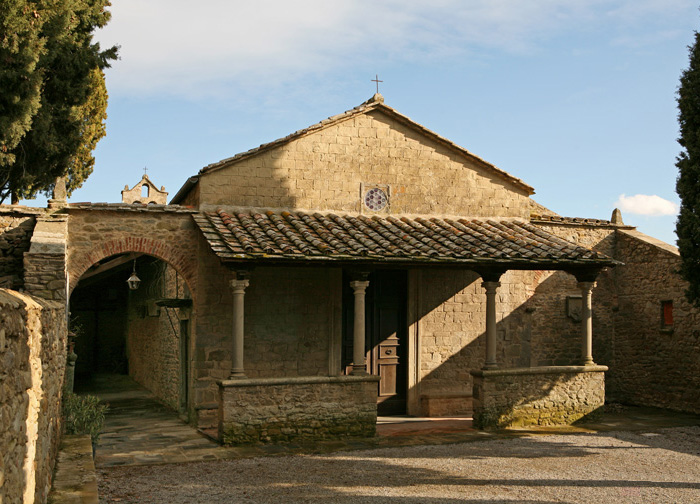 |
||
| Chiesa di San Nicolò |
||
| Above the center, half-way up to the Fortezza, beyond a cypress-lined courtyard, is the 15th century Chiesa di San Nicolò. The 15th-century church has a small porch with slender columns and the interior houses paintings by Luca Signorelli: the two-sided panel-painting, Descent from the Cross and Madonna Enthroned, and a fresco, Madonna with Saints. Ring the bell and ask the custodian to flip the panels. |
||
| At the very top of Cortona stand two impressive monuments. The first is the 14th century Santuario di S. Margherita da Cortona (the sanctuary of S. Margherita from Cortona) containing the Gothic tomb of the saint herself. The second is the Fortezza Medicea (or Fortezza del Girifalco), built in 1556 on a rock, from where views over the Val di Chiana and Lake Trasimeno can be appreciated. From Piazza della Pescaia, a steep path leads up to La Basilica di Santa Margherita, resting place of St Margaret of Cortona, the town's patron saint. |
||
| La Basilica di Santa Margherita was constructed on the site of a church dating back to the 900s (also proposed to be originally the site of an Etruscan temple). Santa Margherita di Laviano died in one of the cells here on Feb. 22, 1297. Most of the current structure dates to a remodel by Guiseppe Castelucci in 1895. Other than the precious works of art preserved in its interior, on the altar there is a silver urn containing the body of Santa Margherita. La Basilica di Santa Margherita can be reached on foot on the old road leading to the Convent of Le Celle or walking through the old part of town through the narrow alleyways of the quarter called Poggio San Marco. Cortona is surrounded by defensive walls, the foundations of which date back to the Etruscan period and are easily recognised as such by their cyclopian construction, so different from the regular rows of large squared blocks laid down in Roman times and smaller ones from the mediaeval period. Tightly-clustered mediaeval houses pack the slopes, leading upwards to an open green area in the middle of which is the huge Medici fortress, the Fortezza Medicea. |
|
|
| The Renaissance took hold anew of the ideal of the centralised ground-plan for church-building. Two of the churches in Cortona are prime examples of two different principles of Renaissance construction, the Santa Maria Nuova and the Chiesa di Santa Maria delle Grazie al Calcinaio. |
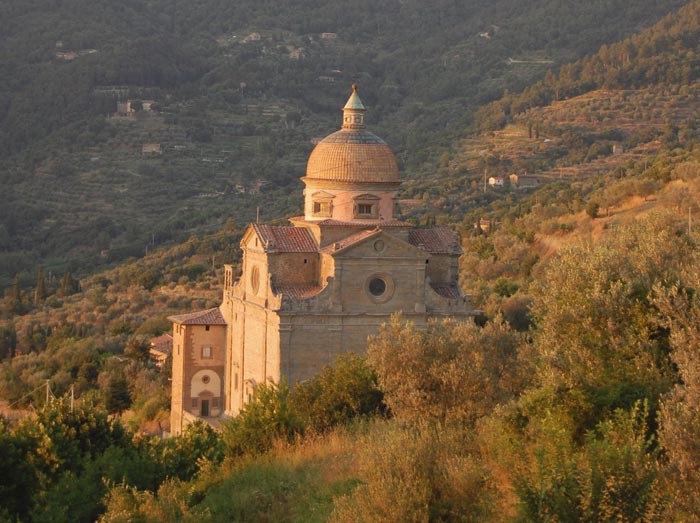 |
Santa Maria Nuova |
Santa Maria Nuova, built by Giorgio Vasari in 1554, is a church of square ground-plan. This building is of extreme interest for its ground-plan of a Greek cross and surmounted by a main cupola which was only finished during the 17th century, a primary example of such a centralised design. Inside rise the four mighty columns on which the lantern of the cupola is supported. At the sides the four arms of the cross branch out covered with barrel-vaults, while four small cupolas arise in the spaces of the angles. Among the works of art are the Nativity by Alessandro Allori, San Carlo Borromeo che porta la Comunione agli appestati by Baccio Ciarpi, and the Annunciation dell'Empoli. The church is unfortunately not in very good condition, and is not open for sightseeing. |
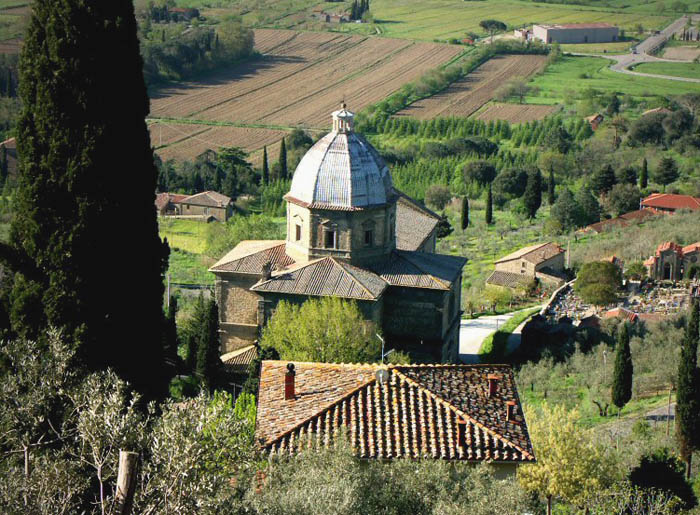 |
Chiesa di Santa Maria delle Grazie al Calcinaio |
From the Piazza Garibaldi a twisting road with four sharp bends descends for 3 km to the southern slope of the town hill, on which stands the church of Santa Maria del Calcinaio, a beautiful domed building on a cruciform plan by Francesco di Giorgio Martini of Siena. It was built in 1484-1515 by Francesco di Giorgio Martini (1439-1502) in connection with an alleged miracle-performing image of the Blessed Virgin Mary, the Madonna del Calcinaio (originally on the wall of a lime pit = calcinaio). |
Chiesa di San Benedetto, built originally in the 14th century on the foundations of an Etruscan tower, was entirely rebuilt in 1722 by the Scolopi Fathers, who changed the original rectangular design into its current oval shape. In the 18th century the Florentine painter Taddeo Mazzi decorated the interior with frescoes of the Madonna and St Joseph. |
| Cortona hosts several events amongst which the Fiera del Rame (copperware market – late April), the Giostra dell’Archidado, a costume cross-bow competition (in May), the Steak Festival (August 15th), the Antique Fair (late August-early September), the Tuscan Sun Festival, (August). |
| In the eleventh century the palace was the result of the rural aristocracy of the high middle ages moving beyond their castles and establishing themselves within the urban walls of the free Comune. They were the exclusive homes of well-to-do families in contrast to the casa, the house of the commoner and the church which was the house of God and all. The aristocratic families then came to became solidly planted in public offices as well. From the 1500's to the 1700's they demonstrate their wealth and power by building palaces, from the restoration of old houses or by creating new ones. These palaces of Renaissance or Baroque architecture were adorned with family crests. At one time the interiors were rich with precious works of art, paintings, sculpture, furniture, libraries and archives which today for the most part have been stripped bare and their treasures for the most part dispersed as opposed to the churches which still contain a good part of their prestigious antique works. The coats-of-arms or stemmi of the many noble Cortonese families can be seen in the courtyard of the Palazzo Casali as well as above the entries of many buildings in town. Palazzo Casali (13th century, with facade by Filippo Berretini ca 1613), now houses the Museo Etrusco and the Cortona library (Biblioteca del Comune), with an extensive collection of historic documents, including over 700 manuscripts and 6,000 volumes regarding local history. |
||||||||||||||||||||||||||||||||||||
| Palazzo Petrella (15 Via Guelfa). Contrary to the others it is the only one which is still inhabited by the heirs of the family which built it. It conserves in its interior notable objects of value among which are library with various parchment and paper manuscripts from the fourteenth century. The library includes a three volume manuscript containing the constitution of Cortona. |
||||||||||||||||||||||||||||||||||||
| Palazzo Tomassi can be found at number 1 Via Dardano. The palace should be remembered because a good part of the artwork and furnishings held in interior, paintings, furniture, ceramics, etc, were the property of Girolamo Tommasi the last descendant of this prestigious family, and now on display at the Etruscan Academy Museum after they were donated by the widow Giulia Baldelli-Boni in the first years of this century (1932). The palace is now property of the bishopric. | ||||||||||||||||||||||||||||||||||||
|
||||||||||||||||||||||||||||||||||||
| The decision to locate the villa outside the town, near a spring called Cumula, on a hillside of olive and cypress trees, lead to the choice of a fortified structure with a 42-meter-high tower and an impressive battlement wall from which the Trasimeno Lake can be seen. The Renaissance palace Palazzo Passerini a Fontecumola (called Il Palazzone) was constructed in 1521 by architect G. Battista Caporali ordered by the cardinal, Silvio Passerini, whose coat of arms is on the key of the entrance arch. The paintings of Luca Signorelli can be admired in the nobleman's chapel as well as frescoes by F. Bernabei, considered one of his most prestigious students. Bernabei, called the Papacello, frescoed the hall of honour with scenes of Roman history, among which should be noted the battle of Trasimeno, the death of Marco Curzio and the head of Hasdrubal thrown into Hannibal’s camp. [read more] |
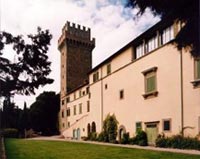 Villa Palazzone |
|||||||||||||||||||||||||||||||||||
| In the area a must-see is the Abbey of Farneta that today houses also a small museum of Paleontological and archeological materials from the immediate area. Of interest also are the church of Saint Michael in Metelliano, the splendid castle Rocca di Pierle and the Franciscan Monastery of Le Celle. Le Celle di Cortona, a Franciscan convent, holds the spartan cell where St. Francis stayed when he preached there in 1211. It's about a 45 minute walk through the woods outside Cortona's walls. The church and gardens can be visited for free. Also close by and visible from Cortona is Lago Trasimeno, site of the legendary and bloody battle in 217 BC (the Second Punic wars of 218-201 BC) in which Hannibal's troops defeated the Romans led by Gaius Flaminius Nepote. The Franciscan hermitage Le Celle (Convento delle Celle or Convent of the cells) is just five kilometres from Cortona at the feet of Mount Sant’Egidio. In 1211 St Francis along with a few of his followers built the first nine cells of the hermitage and the place has taken the name of Celle ever since. The Pieve di San Michele Arcangelo with its harmonious architecture along with the great spiritual atmosphere makes it one of the most beautiful of the Aretine valleys. it was proclaimed a national monument in 1907. The church is situated at the entrance to the valley dell'Esse, about 5 kilometres from Cortona. |
||||||||||||||||||||||||||||||||||||
| The Farneta Abbey, a medieval church with an interesting small paleontological museum, is situated in the Chiucio hills of the Valdichiana, on the road between Cortona and Foiano. It is an ancient abbey, founded by the Benedettini Neri (Benedictine) monks on the site of a Roman temple. Address: loc. Farneta, Abbazia di Farneta. Open 9 -13 and 14 -16 on request. |
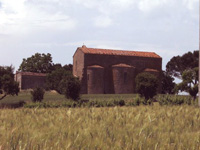 Abbazia di Farneta Abbazia di Farneta |
|||||||||||||||||||||||||||||||||||
| Lake Trasimeno or Lago Trasimeno, is the fourth largest lake in Italy and the biggest on the peninsular. The main towns, all quite small, are Passignano sul Trasimeno, Tuoro, Monte del Lago, Torricella, S.Feliciano, S.Arcangelo, Castiglione del Lago and Borghetto. Castiglione del Lago has the longest shore, because its on the only significant peninsula of the lake. There were stories that this was an island that was joined to the shore by the Romans. Castiglione del Lago, has some Roman ruins and its main streets are structured like a chessboard in the Roman style. All around the lake there are old small towns, and isolated castles. Between Monte del Lago and S.Feliciano there is the old Zocco castle, one of the biggest castles of the area and the only one that, inside its sandstone walls, has a still untouched medieval keep. [read more] The Leaning Tower of Vernazzano (around 20 m in height), on the northern shores of Trasimeno Lake, perhaps leans even more than the famous leaning tower of Pisa. This unique remnant of an ancient castle was built before 1089, when the whole castle was donated by Marchiones family to the monastery of Città di Castello. In 1202 began under control of Perugia and so this city gained the control of Northern Trasimeno. It was built on M.te Castiglione, near two torrents. The castle and the surrounding settlement at Vernazzano, were damaged by wars in 1400s and two century later, by a strong earthquake (followed by damaging after-shocks). Erosion of the foundations by torrents caused the tower to lean in the eighteenth century. Isola Maggiore is the second largest island on Lake Trasimeno, in Umbria, central Italy. It is a frazione of the comune of Tuoro sul Trasimeno, and is the only inhabited island on the lake.
St Francis of Assisi lived on the island as a hermit from 1211. The 12th century Church of Saint Michael the Archangel was built on the top of the hill. |
||||||||||||||||||||||||||||||||||||
| The history of Val di Pierle is closely linked to the history of the splendid castle (la Rocca di Pierle) which dominates the valley. Pierle Castle can be rightly considered one of the most beautiful and powerful examples of feudal castle in Tuscany, its defiled location and the lack of restorations in the last five centuries relegated the castle in the dark of the abandonment and degradation, state in which it lies since the year 1587. The fortification now lies in ruin, but still today it gives off all its great power and magnificence. Reschio Castle lies at the border between Tuscany and Umbria, in Lisciano Niccone commune. Two rivers flow at the sides of this caslte: Niccone on the northern side and Marte on the eastern side. The walls of the castle contain a palace, the towers, the former prisons and the church of Reschio built in the name of San Michele Arcangelo. The castle with its single main entrance was built before the year 1000 and belonged to the Marquesses del Monte until 1200. One of the most beautiful and ancient churches in the valley of Arezzo is the Church of San Michele Arcangelo in Metelliano, called simply the church of Sant’Angelo of Cortona. The church is situated at the foot of a marvellous hill, which slopes down sweetly from the walls of Cortona to the green Val D’Esse. The region of Val D’Esse belonged to a noble roman family, Gens Metellia, who gave their name to this place: Metelliano. A roman road, which later became the most important in the region, led to the church. The farmers made built a temple in the place, where there is now the church. The temple was dedicated to Bacchus, God of wine, joy and popular celebrations, which were also known with the name of God: “Baccanali”. The temple stands, more or less, in the centre of the church. The church of Saint Michael the Archangel at Metelliano is found at the entrance to the valley dell'Esse about 5 kilometres from Cortona. The Pieve di San Michele Arcangelo that dates back to the 11th century, presents a simple double jutting façade, typical of Romanesque churches. The portal, with a rounded arch, is surmounted by a loggia with small, travertine columns and capitals typical of archaic Romanesque, next to two narrow windows. Amongst the theories about its construction, there is one which dates it back to Maginardo Aretino, on behalf of the Bishop of Arezzo, Teobaldo, who would have sent him to Ravenna to study the Romanesque and Byzantine. Inside, alongside the elements of true Romanesque-monastic architecture (three naves with apses), there are also signs of a break with tradition such as the new verticalism (emphasized by the alternating large Romanesque pilasters with slender Byzantine columns, topped by truncated pyramid capitals) which seem to announce the imminent Gothic. The columns, with the exception of the last two near the presbytery, carne without doubt from an earlier building (one can see their irregularity and the cuts made to adapt them to the height of the church). The façade is also probably the result of an adaptation of an earlier building (see the little room above the central doorway). Internally, the church is 28.50 m. long, 10.80 m. wide and 10 m. high. Unlike primitive basilicas, it does not have a crypt. The central apse is double the side apses, and higher with the transenna which look onto the roofs of the side naves. The apses, circular on the outside, are sparsely decorated, with blind arches, typical of architecture between the 6th and 10th centuries. |
|
|||||||||||||||||||||||||||||||||||
| The Villa Tommasi in Metelliano dates back to the 18th century and consists of the large ancient master’s villa, a green-house – lemon-house and a family chapel and is owned since the 16th century by the Tommasi family, one of the most prominent families in town. The villa was originally built in the 16th century as a country residence and appeared back then as a sober building lacking any sculptural detail and architectural formalism. In the second half of the 18 th century when the villa was owned by Cav. Niccolò di Annibale Tommasi of the Order of Santo Stefano an extensive restoration project was undertaken through which the brick main entrance, the first part of the lemon-house and the chapel, dedicated to Saint John the Evangelist, were added to the original structure. The villa underwent substantial restoration in the 19th century and it was then that the imposing central roof-terrace was added to the building. Gardens in Tuscany | The Villa Tommasi in Metelliano |
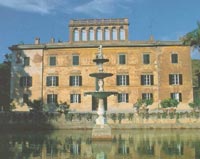 The Villa Tommasi in Metelliano |
|||||||||||||||||||||||||||||||||||
| Castiglion Fiorentino lies in eastern Tuscany, roughly half-way between Arezzo and Cortona. To the west the land falls away to the Val di Chiana. Castiglion Fiorentino, still surrounded by its medieval walls, is commandingly situated on a hill. In the town's main square, the Piazza del Município, the 16th century Loggia del Vasari has a fresco of the Annunciation and old coats of arms. The Church of San Francesco, built in the second half of the 13th century in the period of transition from Romanesque to Gothic, has a beautiful facade and contains a number of good pictures and frescoes in its side chapels. The cloister was added in the 15th century. Near the Porta Fiorentina, a 14th century town gate, stands the Collegiate Church of San Giuliano, rebuilt in Neo-Classical style in 1840-53. At the Porta San Michele is the Church of the Madonna della Consolazione (1607), a late Renaissance building on an octagonal plan. It has an elegant interior, with a fresco, Madonna, attributed to Luca Signorelli. The Castle of Montecchio Vespone is a walled, castle with turrets and battlements, which occupies the top of a hill (Montecchio), overlooking the Val di Chiana. Today the Castle of Montecchio Vesponi is the last surviving medieval bastion of its type and is an essential element in the history of the region. Castello di Montecchio Vesponi is located 4 km south of Castiglion Fiorentino, on the road SR71 and SS71 to Cortona. |
||||||||||||||||||||||||||||||||||||
| Cortona was the setting of Frances Mayes' book and the film Under the Tuscan Sun. Many visitors also want to see Bramasole, the house in Under the Tuscan Sun. To get to the house, walk all the way through the Giardino Pubblico, go past the Tennis Club, and continue on viale Passerini uphill for 1km. Bramasole is on your left. You can also drive past Bramasole: take the road on the west side of Cortona to Torreone; turn right at Torreone towards the Church of S. Margherita and, where that road splits into three at a small Bar, take the road to the left downhill; Bramasole will be on your right in 0.5km. Under the Tuscan Sun. Directed by Audrey Wells. With Diane Lane, Sandra Oh, Lindsay Duncan. While on vacation, a just-divorced writer buys a villa in Tuscany on a whim, hoping it will be the start of a change for the better in her life. Other films: Andre Rieu: Live in Tuscany (2004) (TV), Canterbury proibito (1972), La vita è bella (1997), Life Is Beautiful (1998) (UK) (USA), Moon in Taurus (1980), Der Mond im Zeichen des Stiers (1980) (Switzerland: German title) and Sotto il sole della Toscana (2004) (Italy). |
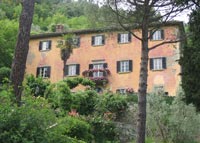 Villa Bramasole |
|||||||||||||||||||||||||||||||||||
Youtube Trailer: Under the tuscan sun
|
||||||||||||||||||||||||||||||||||||
|
|
||||||||||||||||||||||||||||||||||||
Map | City map of Cortona |
||||||||||||||||||||||||||||||||||||
Walking and Trekking in Tuscany | Circular Walks on the Tuscany Umbria Border |
||||||||||||||||||||||||||||||||||||
Cortona City Walk | Download pdf |
||||||||||||||||||||||||||||||||||||
|
||||||||||||||||||||||||||||||||||||
| Castiglione del Lago and the hills between Lake Trasimeno and Tuscany |
||||||||||||||||||||||||||||||||||||
|
||||||||||||||||||||||||||||||||||||
 |
||||||||||||||||||||||||||||||||||||
Podere Santa Pia, April |
||||||||||||||||||||||||||||||||||||
|
||||||||||||||||||||||||||||||||||||
Restaurants in Cortona |
||||||||||||||||||||||||||||||||||||
|
||||||||||||||||||||||||||||||||||||

